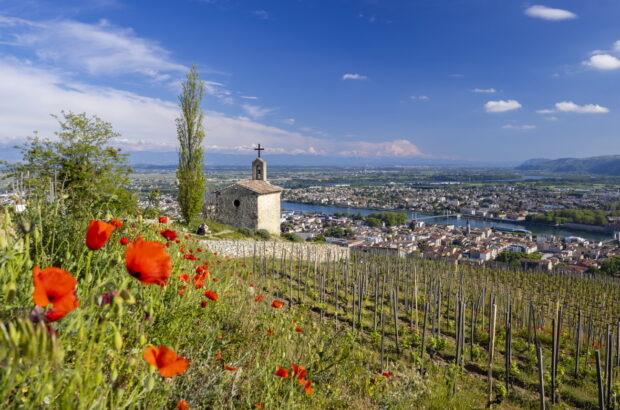Promotional feature
Tinazzi: family winemakers in Valpolicella and Lake Garda
How do you get to be a family company and produce quality wines for 50 years? Founded in 1968, Tinazzi is a family-owned winemaking enterprise driven by a “tradition-plus-innovation” mantra. Nowadays, the company owns several wineries and estates in two key regions of wine production in Italy: Veneto and Puglia. This is their receipe for becoming a well-established company without losing a focus on quality.
1. Start from the bottom: a tiny village in the Verona province
The Tinazzi adventure started in 1968 when the company was founded by patriarch Eugenio Tinazzi. His son Gian Andrea was only 18 years old when he started to produce and sell wine from a tiny cellar in a small village of the Veneto. Gian Andrea was extremely poor, but driven by passion, perseverance and an entrepreneurial spirit. Over 50 years, the company has expanded rapidly in the Veneto and Puglia regions. Today, Gian Andrea’s children Giorgio (Sales and Marketing Director), and Francesca (Management Control) help him supervise the family enterprise.
2. Move the headquarters to a more suitable site, for logistics.
Shortly after the company’s foundation, the headquarters was moved to Lazise (where it still is) for better transportation links: today, Tinazzi exports its products to more than 30 countries. In Lazise, oenologist Giuseppe Gallo and his staff supervise the whole production process, from vineyard to bottle. The white wines of Veneto and the red wines of Lake Garda (Bardolino, Corvina…) are vinified here using the most advanced technology.
3. Believe in native grapes
In 1986, Gian Andrea Tinazzi purchased a country estate located in the enchanting hills of Lake Garda from a community of local friars. After a careful restoration, Tenuta Valleselle became the company’s hospitality centre. With its 12 hectares of vineyards and olive trees, the estate hosts wine lovers and professionals all year round. Guests learn how to cook homemade pasta and taste what they have prepared, pairing the food with a glass of wine.
Starting with the acquisition of Tenuta Valleselle, Tinazzi has purchased several other wineries and estates in Veneto and Puglia. Nowadays, the company is implementing an important country estates project, aimed at producing high-quality wines with native grapes varieties. The latest purchase is Cascina Montelupo in the Custoza area (Veneto), which makes an eponymous white that has found favour on international markets in recent years.
4. Fall in love with the “heel of the Italian boot”: Puglia
In the 2000s, during a trip to the Salento peninsula, Gian Andrea Tinazzi came to understand the potential of Primitivo and other native grape varieties and invested in the Feudo Croce estate. Later on, Tinazzi wineries took over the Cantine San Giorgio cooperative that is now used as the base for the entire company production in Puglia.
5. Most importantly – keep on producing Valpolicella wines
Despite the fact that the family has made profitable investments in Puglia, the success of the winery is still largely determined by the high reputation of Valpolicella wines.

The family
Amongst the vineyards of the enchanting valleys of Valpolicella, there is one new estate that stands out at an altitude of no less than 600 metres: Poderi Campopian, the Tinazzi family’s new estate in the heart of Valpolicella Classico above the village of Sant’Ambrogio di Valpolicella. Twelve ha of vineyards benefit from an excellent exposure to the sun, and make limited editions of classic regional wines: Marziale Amarone della Valpolicella Classico DOCG and Lunante Valpolicella Classico, for example.
The spirit of achieving high-quality wines from Poderi Campopian is the same spirit that drove Gian Andrea Tinazzi at the very beginning of his career 50 years ago. Despite the fact that the company has become a well-established and complex reality, attention to tradition and excellence has never wavered.
 Monterè Valpolicella Ripasso Superiore, Ca’ de’ Rocchi
Monterè Valpolicella Ripasso Superiore, Ca’ de’ Rocchi
Ca’ de’ Rocchi is the Tinazzi family’s traditional brand – the core business of the company – and Monterè Valpolicella Ripasso Superiore is just one of the award-winning wines that are part of this brand. It’s named after the “Monte Rè”, a mountain near a small village in the Veneto where the Tinazzi company was founded. The grapes for Monterè – Corvina, Rondinella, Molinara – are harvested by hand at the beginning of October and the wine is passed over (“ripasso” in Italian) the skins of grapes used for Amarone at the end of the following January.
This full-bodied (14%) and long-finishing wine is matured for 12-18 months in French and American oak barrels. On the nose it has aromas of prunes, sour cherries and spices with a streak of balsamic. On the palate it’s well balanced, with strong flavours and smooth tannins.
It pairs well with autumn risottos and meat dishes, with or without the traditional Veronese pearà sauce.
Tinazzi’s appassimento centre in Sant’ Ambrogio di Valpolicella
In 2015, Tinazzi opened a new grape drying, pressing and vinification plant in Sant’Ambrogio di Valpolicella. Here the best grape bunches, harvested at the beginning of October, are put on special trays for drying called plateaux. The grapes are left in a drying room (fruttaio) until the following January before they are destemmed and crushed. The red wines made with this appassimento technique are matured in a beautiful barrel room, filled with 5, 10 and 20 hectolitre French and American oak barrels.
This is the where special guests, especially wine journalists and trade representatives, come to enjoy the red wines of Valpolicella in a special tasting room – entirely made of glass.







